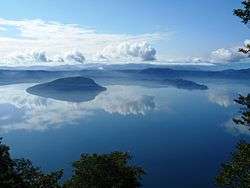Lake Towada
| Lake Towada 十和田湖 | |
|---|---|
 | |
| Location | Honshū, Japan |
| Coordinates | 40°28′N 140°52′E / 40.467°N 140.867°ECoordinates: 40°28′N 140°52′E / 40.467°N 140.867°E |
| Type | Crater lake |
| Primary outflows | Oirase River |
| Basin countries | Japan |
| Surface area | 61.1 km² |
| Average depth | 71 m |
| Max. depth | 327 m |
| Water volume | 4.19 cubic kilometers |
| Shore length1 | 46 km |
| Surface elevation | 400 metres (1,312 ft) |
| 1 Shore length is not a well-defined measure. | |


Lake Towada (十和田湖 Towada-ko) is the largest crater lake in Honshū island, Japan. Located on the border between Aomori and Akita prefectures, it lies 400 meters (1,800 ft) above sea level and is 327 m (1,073 ft) deep, drained by the Oirase river. With a surface area of 61.1 km², Towada is Japan's 12th largest lake, its bright blue color is due to its great depth. The lake is roughly circular, with two peninsulas extending from its southern shore approximately one-third into the center of the lake.
The lake is a popular tourist destination.
History
Lake Towada occupies the caldera of an active volcano, with large scale volcanic eruptions occurring approximately 55,000, 25,000 and 13,000 years ago. The most recent eruption left traces of pyroclastic flows as far away as the modern city of Aomori. The lake is a double caldera in that the inlet between its two peninsulas (called the “Nakaumi”) is the remnant of a secondary caldera which erupted and collapsed approximately 5400 years ago. The mountain continued to erupt well into the historical period, with the last recorded eruption occurring in 915 AD, devastating the surrounding area with pyroclastic flows, and covering most of the Tōhoku region of Japan with volcanic ash, leading to crop failures, climate change and famines.
The area around Lake Towada remained largely wilderness until towards the end of the Edo period, when the Nambu clan of Morioka Domain attempted large scale land reclamation projects at Sanbongihara (modern Towada) using the Oirase River for irrigation. In 1903, largely through the efforts of Wainai Sadayuki, princess trout were introduced into Lake Towada. The lake now also has rainbow trout, cherry salmon, carp, Carassius, Japanese eel. The surrounding forests are temperate deciduous, and are primarily Erman’s birch and Siebold’s beech.
The lake was selected by the Tokyo Nichi Nichi Shimbun and Osaka Mainichi Shimbun[1] as one of the Eight Scenic Views of Japan in 1927. In 1936, the lake and surrounding areas became part of Towada National Park.
In 1953, in order to popularize the lake and the park, a sculpture of two women titled “The Maiden Statue” by Kōtarō Takamura was dedicated at the lakeshore as part of the park's 15th anniversary celebration. It was the last work by that noted sculptor.
A wartime Tachikawa Ki-54 aircraft of the Imperial Japanese Army Air Force which crashed in 1943 was found at the bottom of Lake Towada on 13 August 2010. It was recovered on September 5, 2012[2] and has been placed on display.[3]
See also
- List of Special Places of Scenic Beauty, Special Historic Sites and Special Natural Monuments
- Tourism in Japan
References
- ↑ "日本八景(昭和2年)の選定内容" (PDF). Ministry of the Environment. Retrieved 17 March 2011.
- ↑ September 5, 2012 Retrieved April 2, 2016 Template:Icon ja
- ↑ 旧陸軍練習機、十和田湖で発見…戦時中に墜落:社会 : YOMIURI ONLINE(読売新聞)(Japanese)
- Southerland, Mary and Britton, Dorothy. The National Parks of Japan. Kodansha International (1995). ISBN 4-7700-1971-8
External links
| Wikimedia Commons has media related to Lake Towada. |
- Towada - Japan Meteorological Agency (Japanese)
- "Towada: National catalogue of the active volcanoes in Japan" (PDF). - Japan Meteorological Agency
- Towada - Geological Survey of Japan
- Towada: Global Volcanism Program - Smithsonian Institut